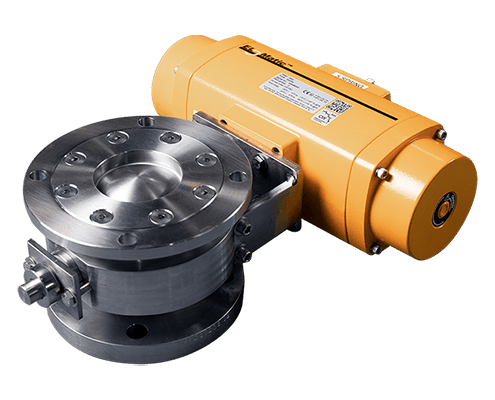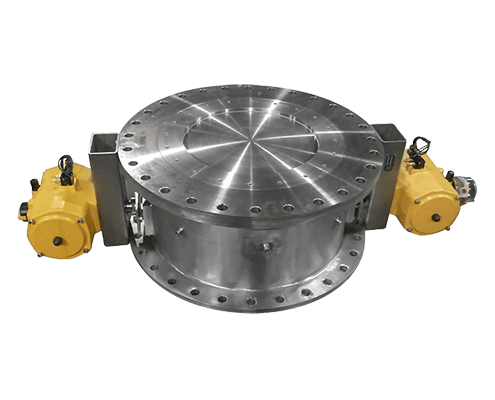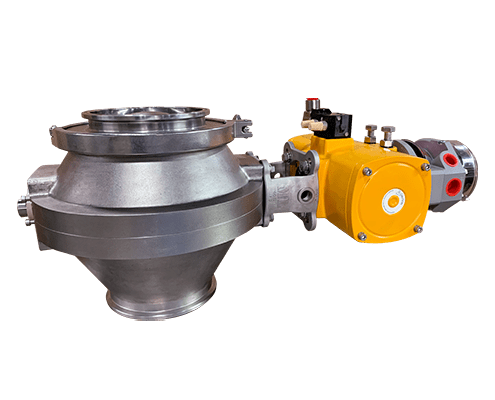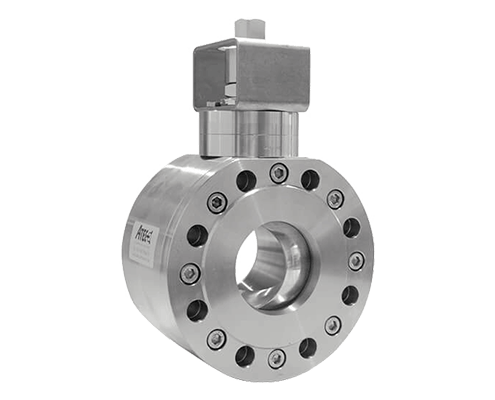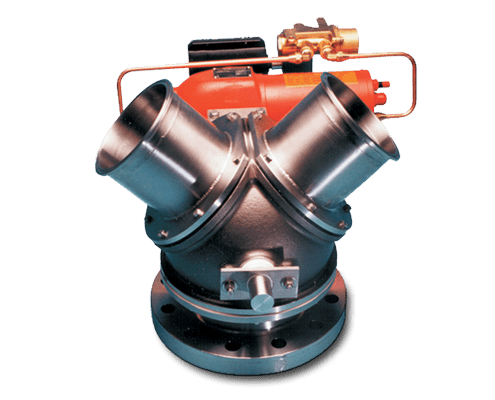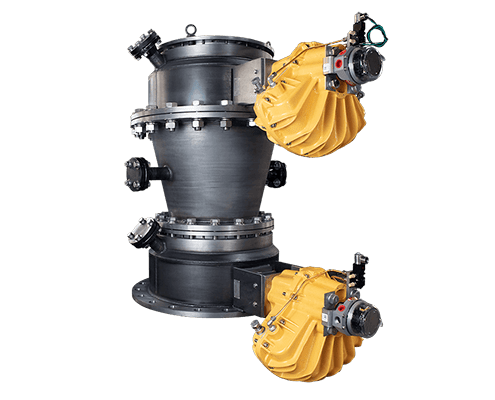Table of contents
Top 10 Features of the P21 Gemco Valve
The spherical disc valve / dome valve has some unique advantages for handling difficult dry and slurry material applications.
Click on the numbers below to see the top 10 features of the P21 Valve.
Know Your Specific Application
Knowing your valve function, the materials that are processed, operating pressure, temperature, specific requirements, size and flow will help insure you are able to specify the correct valve for your application.
Determine the answers to the following questions:
What industry will this valve be used in? Agricultural & Farming, Energy, Food & Beverage, General Chemical, Manufacturing, Pharmaceutical, or Plastics.
What typical materials (media) are being processed? Is the material abrasive, corrosive, light, or heavy? Are there sanitary requirements?
What are the weight considerations? The weight of a valve is especially important for mobile or rotating equipment. High performance and heavy-duty models can weigh four times as much as its regular-duty counterpart. Dust tight, full vacuum, and 1 bar service, is considered to be regular duty service. 90 PSI (6bar) to 150 PSI (10bar) is high performance. An 8-inch manually operated regular duty valve can weigh 55 lbs. (25Kg), versus nearly 200 lbs. (90Kg) for an 8″ high performance model.
What is the valve function? Inlet valve, outlet valve, or pipe inline valve?
What is the operating pressure range?
What is the operating temperature range? High temperature requirement?
What are the port inlet and outlet sizes?
Determining the Valve Size
Size is dictated by the product flow characteristics and required flow rate. Powder bulk solids have a wide range of characteristics that affect their flow. There are no well-defined formulas for determining the best valve size. Contact us with your mass flow requirement for your specific media. We have extensive experience with all varieties of materials and processes. If we have no empirical data available, a lab test can be helpful as a guide. If you have a new or very complicated process, we recommend the experts at Jenike & Johanson for their powder and bulk solids handling, processing, and storage technology.
Understand Material of Valve Construction (compatibility and durability differences)
Material of valve construction: The powders and/or solvents to be processed will dictate the product contact material. Cast Iron and Carbon Steels can be used for many industrial applications. Corrosive processes will call for the use of Stainless Steel, and in some cases material laden with solvents or other corrosives will justify the extra expense of using Hastelloy or other high nickel alloy to prolong valve life.
- Cast Stainless Steel – Cast CF8M (316) Stainless Steel
- Stainless 316L – For Stainless Steel valves of welded construction, 316L grade is preferred. It is more corrosion resistant than 316 Stainless Steel, and the lower carbon content prevents carbon precipitating from the welded joints.
- Carbon Steel – An alloy consisting of iron and carbon and may be used for many industrial applications.
- Hastelloy – Offers superior protection and is used to prolong valve life for material laden with solvents or other corrosives.
- Cast Iron – Cast Iron
Choosing a Valve Surface Finish (Sanitary Requirements)
The sanitary requirements of the process will govern the surface finishes and other sanitary options.
Finishes:
- No surface finish (Ra) specified. Sometimes referred to as “mill finish” or “as cast”. Fabricated valves will only have the internal welds ground smooth and flush. Common in general industrial applications where cross contamination or cleanability are not a concern.
- #2 finish – Ra 33 to 65 microinch – 150 to 180 grit. Also referred to as “buffed, blended or uniform appearance finish”. Often specified for the outside of equipment that will be washed down.
- #4 polish – Ra 16 to 32 microinch – 180 to 240 grit. All fabrication and handling marks removed. Surface is buffed to a uniform satin finish. The #4 polish is typical for the interior of equipment that needs to be cleaned between batches to prevent cross contamination.
- #7 polish – Ra 10 to 15 microinch – 240 to 320 grit. All surface imperfections are repaired. Often referred to as “pit free” and “mirror finish”. Used for high purity applications such as processing potent pharmaceutical actives. Also used for products that tend to adhere to surfaces.
For automatic cleaning, spray balls or jets should be considered. Another option is the Sani K Valve that can be dismantled by hand for inspection and cleaning. For safety reasons the size of such valves are typically limited to an 8″ port diameter due to the weight of individual components.
Learn About Valve Options
Mounting: The typical ANSI 150 # and DIN drilling is used as an industry standard for heavy duty and high-performance models. Quick clamps can also be used for applications up to 30PSI (2bar) and port sizes up to 10″. For 1″ to 3″ VB ball valves NPT, Socket weld and Tri-Clamps connections are options.
Some valves will include blind tapped holes, which may be a problem if the valve is mating with existing blind tapped holes. Another option is to choose over-sized flanges, which allows for through holes. For regular duty service valves, ANSI and DIN bolting can be overkill and alternative bolting patterns are available.
- No Clamps
- ANSI 150#
- Tri Clamps
- Gemco Mounting
- DN PN10
- Cover Clamps
- NPT
- Socket Weld Connections
Seats: Very abrasive material will tend to dictate using metal seats versus the more commonly used reinforced Teflon seats.
The metal seal will give longer life and can be used at higher temperatures than Teflon but the shut-off sealing is limited to dust tight, ANSI class IV or ANSI class V. Reinforced Teflon can be used up to 450 degrees F (230 C), and provide Class VI shut-off.
- Teflon
- Metal
- Inflatable Seat
Service: Dust tight are used for most gravity feed powder applications where the process is not under vacuum or pressure.
- Dust Tight
- Liquid Tight
- Vacuum
- Low Pressure
- Pressure
- High Pressure
O-Ring Material: Silicone O-rings are typical. Viton and Teflon Encapsulated Silicone are used for specific chemical resistance. Most other materials are available on request.
- Silicone
- Viton
- Teflon encapsulated
Operators (Actuators): Double acting pneumatic operation is the first choice for reliability, speed, weight, and value. Levers and gear drives are also available. Pneumatic operators are available in double acting or single acting (spring return) fail-safe modes. Spring return actuator are slower, bigger, and heavier.
As with other quarter turn valves; levers, gear drives or chain operators are available. Pneumatic and hydraulic, operators are available in double acting or fail-safe modes. Pneumatic operation should be the first choice for price, reliability, and speed. When handling solids a higher factor of safety is used to calculate seat torque requirements. The factor is typically 1.5 instead of the 1.25 used for liquid and gas valve calculations.
For solids that “set-up” or harden over-sized actuator and specially designed discs that can break through the hardened cake are used. Actuators are typically sized for 80-PSI (5.3 bar) pressure. If the available supply air pressure is dependably higher (100 to 120PSI) or lower (40 to 60 PSI), this will factor in the sizing of the actuator.
For fail-safe operation, spring return actuators are the norm. When a spring return type actuator is used, it is over-sized to compensate for the spring as well as the unseating, run, and seating torque required for valve operation. This can lead to weight and space problems as well as extra cost. An alternate fail-safe option is to use a double acting actuator with a pneumatic accumulator sufficiently sized to close the valve. If there is a loss of pneumatic pressure, a pressure switch activates the accumulator and operates the valve.
- No Operator
- Manual Lever
- Air – Double acting
- Air – Spring Return
Control: Single solenoid (spring return) fail closed on loss of control signal is typical. Fast acting (1 to 5 seconds), quarter turn valves are ideal for flow control of solids. A pneumatic (3 to 15 PSI) or electro-pneumatic (4 to 20 milliampere) positioner can take a signal from a manual adjusted pressure regulator, or from a computer controller. The pneumatic positioner is often used in manually operated filling stations, while the electro-pneumatic positioner is typical for variable discharge which is often used for automatic loss-in-weight systems.
- No control required
- Solenoid
- Pneumatic Positioner
- Electro-Pneumatic Positioner
Feedback: Typical for automated valves is two mechanical limit switches indicating fully open and fully closed with a visual beacon indicator.
- Position Indicator
- Visible Beacon
Electrical Classes: NEMA 4/IP64 wash down and Explosion proof NEMA 7 and 9 are standard. Other classification including IS Intrinsically Safe are offer as engineered options.
- Wash Down
- X-Proof
- Intrinsically Safe
Voltage: The Voltage of an electrical appliance indicates the voltage at which the appliance is designed to work. Typical power of a single solenoid is 7.2 Watts. The current consumption at that voltage is displayed on a rating plate attached to the appliance.
- 24V DC
- 120V 60
- 240V 50 Hz
Clean in Place (CIP): For automatic cleaning, spray balls or jets should be considered. Another option is the Sani K Valve that can be dismantled by hand for inspection and cleaning. For safety reasons the size of such valves are typically limited to an 8″ port diameter due to the weight of individual components.
CIP ports is a 1-1/2″ ferrule fitted with a Teflon plug, cap and quick clamp. Spray ball is supplied with cap and plug to be used if spray ball is removed between cleaning cycles.
- No CIP required
- CIP port
- CIP Spray Ball
Need help in specifying your unique application? Complete the Request Quote form to the best of your ability and a representative will contact you for further details.
Compare Gemco Valves
P21 High Performance Valve
The P21 is designed for ANSI class VI sealing from full vacuum to 150 PSI and is available in most alloys including carbon steel, stainless steel, Hastelloy and titanium. The P21 is offered with standard ANSI or DIN flanges and ISO actuator mounting. It can be configured with a solid reinforced Teflon (RPTFE) seat, metal seat or inflatable seat. Options include the full range of sanitary finishes and clean in place spray balls or nozzles.
Features and Benefits
- Designed for 10 bar and full vacuum
- Dust tight
- Hi temp 200°C to 800°C
- Can be configured with a solid reinforced Teflon (RPTFE), metal or inflatable seat.
- Can be engineered with flush mount pad to minimize or eliminate “dead space” cavities on mixer discharge.
- Options include the full range of sanitary finishes and clean in place spray balls or nozzles.
Applications
- Engineered for the most demanding applications in general chemical, pharmaceutical and most solids processing industries.
- Heavy duty applications including handling sand and gravels, metal powder, ceramics and other challenging bulk solids.
- Reactor Feed Valve
- Isolation Valve
- Dense Phase Conveying Valve
- Pressure Tank Shut off Valve
Materials of Construction
- Stainless Steel
- Hastelloy
- Carbon Steel
- Titanium
Specify the P21 Valve for your application and get a price quote.
T Heavy Duty Valve
The Type T Valve is designed for heavy-duty service. It is typically used for slurries, abrasives, and heavy density materials. The T valve is available in cast stainless steel, cast iron as standard and can be fabricated from any weldable alloy with the full range of sanitary finishes. Options include high temperature or pressure (3 bar) designs, clean in place spray balls or nozzles and custom adapters or mountings.
Features and Benefits
- Designed for 3 bar and full vacuum
- Dust tight
- Hi temp 200°C to 800°C
- Can be configured with a solid reinforced Teflon (RPTFE), metal or inflatable seat.
- Can be engineered with flush mount pad to minimize or eliminate “dead space” cavities on mixer discharge.
- Options include the full range of sanitary finishes and clean in place spray balls or nozzles.
Applications
- Heavy duty applications including handling sand and gravels, metal powder, ceramics and other challenging bulk solids.
- Tank charging and discharging
- Ribbon/Paddle Blenders
- Bag Dump Stations
- Bulk Bag Unloaders
- Weighing Systems Metering Valve
Materials of Construction
- Stainless Steel
- Hastelloy
- Carbon Steel
- Cast Iron
Specify the T Valve for your application and get a price quote.
TLD Lightweight Valve
The TLD Valve is typically used for processing light density materials such as foods and pharmaceuticals and on rotating and mobile equipment where weight is a concern. It is available in a range of weldable alloys including 316L stainless steel and Hastelloy. The sanitary version of the TLD Valve has full interior and exterior polishes. ANSI and DIN drilling patterns are offered in addition to the Gemco standard pattern.
Features and Benefits
- Designed for 1 bar and full vacuum
- Dust tight
- Can be engineered with flush mount pad to minimize or eliminate “dead space” cavities on mixer discharge.
- Options include the full range of sanitary finishes and clean in place spray balls or nozzles.
Applications
- Light density materials such as foods and pharmaceuticals and on rotating and mobile equipment where weight is a concern.
- Tumble mixer and dryers
- Intermediate Bulk Containers (IBC).
- Mobile vessels and tanks.
Materials of Construction
- Stainless Steel
- Hastelloy
- Carbon Steel
Specify the TLD Valve for your application and get a price quote.
Sani K Valve
The Sani K Valve is designed to USDA/FDA and EHEDG guidelines eliminating threads, keyways and crevices. The split body design means the Sani K Valve can also be completely disassembled with simple hand tools, allowing quick and easy inspection and cleaning. It is used for charging/discharging or in-line with standard quick clamps allowing fast installation and removal.
Features and Benefits
- Dust tight
- Can be engineered with flush mount pad to minimize or eliminate “dead space” cavities on mixer discharge.
- Options include the full range of sanitary finishes and clean in place spray balls or nozzles.
Applications
- Light density materials such and on rotating and mobile equipment where weight is a concern.
- Valve can also be completely disassembled with simple hand tools, allowing quick and easy inspection and cleaning
- Food Processors
- Pharmaceutical equipment
- Cosmetic and Fragrance processing
Materials of Construction
- Stainless Steel
Specify the Sani K Valve for your application and get a price quote.
VB Ball Segment Valve
The VB Valve (1”/25 mm to 3”/75 mm) has full port for mass flow of most free flowing abrasive powders, slurries, liquids and gases. The VB design is a segmented ball that cycles through full flow. The VB is offered with standard flanged (ANSI/DIN), butt weld, tri clamp, or custom connections and is available in most machinable alloys.
Features and Benefits
- Designed for range of pressures and full vacuum.
- Low profile for minimal dead space on tank outlets.
- Abrasive resistance options.
- Hi temperatures options 200°C to 600°C
Applications
- The VB Ball Segment Valve is designed for handling free-flowing powders in 25mm to 75mm sizes
- Chemical
- Pharmaceutical
- Food
- Cosmetics
- Plastics
- Solar
Materials of Construction
- Stainless Steel
- Carbon Steel
- Corrosive/high temperature resistance alloys
Specify the VB Valve for your application and get a price quote.
D-2 Diverter Valve 3-Way
The D-2 Diverter Valve places the Gemco Spherical Disc Valve in a ‘Y’ junction that allows the valve to select a product feed from one of the two inputs, or to direct one incoming stream of material to either of the two outlets. The standard D-2 valve is constructed of 316 stainless steel, but it can be made from any weldable alloy. The two ports can be positioned at 30 degrees, 45 degrees, or 60 degrees off the center-line of the third port.
The D2 Diverter Valve is designed to direct product from one input to either of two outputs or from either of two inputs to one outlet.
- Packing Station alternating valve
- Bypass valve
Specify the D-2 Valve for your application and get a price quote.
Double Dump (Airlock)
Gemco Valve Double Dump / Airlocks are designed to control the flow of material between two atmospheres. Consisting of two Gemco Valves connected by an intermediate chamber. Normal cycling varies from one to three times per minute. Slower cycling is possible and nominal material flows of one half to ten cubic feet per cycle are available. Chamber purge, sight glasses, clean-out ports, and automatic cycling controls are among the custom engineering options available.
Applications:
- Continuous Vacuum dryers
- Thin Film Evaporators (TFE)
- High Temperature Boilers
Specify the Double Dump for your application and get a price quote.
